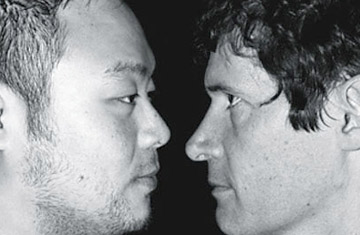
New York City's David Chang, left, and San Francisco's Daniel Patterson
The New York City vs. San Francisco culinary feud has been going on for years and shows no sign of stopping. Chefs in both cities dismiss it as a joke, and maybe it is, but it's the kind of joke that hides a not-so-secret hostility. Unlike Biggie vs. Tupac or the Celtics vs. the Lakers, the rivalry isn't just a random, regional one: there is a real difference in the way the cities can be said to approach food and all the different ways it can be manipulated. David Chang, the ever quotable enfant terrible of New York City gastronomy, rekindled the fire last fall when he dismissed Bay Area cooking. "F______ every restaurant in San Francisco is serving figs on a plate with nothing on it," he said at the New York City Wine and Food Festival. "Do something with your food."
It's a difference worth looking at, and this last week brought a good opportunity to do so. The French culinary organization Le Fooding, which throws some of the coolest food events known to man, organized a bicoastal battle royal in late September in New York City, with some of the top talent from both areas. Chang was there to cook, as were such luminaries as Daniel Patterson of San Francisco's Coi and Jeremy Fox (formerly of Napa's Ubuntu), and a number of other boldface names. The crowd, at least the members I talked to, seemed to take the whole city-feud thing more seriously than not. Many took the hard line. "New York is a restaurant city," one told me truculently. "San Francisco is a food city." What he meant, of course, is that the City by the Bay values the ingredients themselves, not the glitz and technique — a very San Francisco thing to say. One young buck, a line cook in one of Manhattan's most well-known kitchens, added, somewhat wistfully, "It's more fun to cook in San Francisco. People are more willing to eat what you're serving, and more willing to like it."
The food, at first glance, seemed to hew to the stereotypes. Laurence Jossel of San Francisco's Nopa was serving simple grilled Niman Ranch pork on toast with smoked tomato jam. He admitted that his approach, like a lot of San Francisco chefs', was stripped down. "But," he pointed out, "simple isn't easy. We hear all the time: 'I could do this at home.' Then do it! Braise something for five hours at 250 degrees." James Syhabout of Oakland's Commis was serving a scallop that, notwithstanding its stone-fruit dressing, looked pretty plain. "It's definitely a real difference," he told me. "[In New York] you have to be more creative because there's a lack of better ingredients." He then added, in what was surely a well-practiced Bay Area applause line, "A ripe fig is better than an unripe fig that's been manipulated."
On the other hand, some of the food confounded such easy distinctions. California's Fox served up some pugnaciously intricate dishes. One consisted of whipped nasturtium and curry with a black peach panade, basil and leek. Another presented cucumbers in miso bagna cauda with potato bits, olive caramel, ice plant and almonds in lavender sugar. That'll show Chang figs on a plate!
It's fair to say, however, that such elaboration is unrepresentative of the Bay Area style; for the most part, the chefs there generally do "let the food do the talking," as they like to say. Of course, all the New York City chefs say the same thing. Even molecular gastronomists claim to be "all about the ingredients," as they go to great lengths to dehydrate them, spherate them and set them into Brownian motion. But the fact remains that in New York City, where the competition is so great and the talent pool so concentrated, it's not enough to just make a great pork chop. You have to impress jaded critics, keep foodies entranced and otherwise separate yourself from the competition. Because at the end of the day, if all patrons wanted was a perfect peach or a nice piece of chicken, they could stay home and make it themselves. And neither San Francisco nor New York City's chef community wants to see that happen.
Ozersky is a James Beard Award—winning food writer and the author of The Hamburger: A History. His food video site, Ozersky.TV, is updated daily. He is currently at work on a biography of Colonel Sanders. Taste of America, Ozersky's food column for TIME.com, appears every Wednesday.
